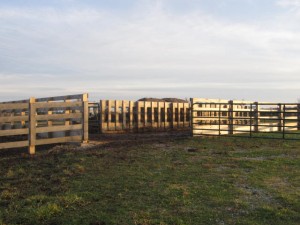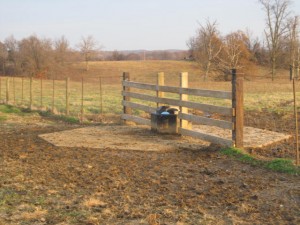– Dr. Roy Burris, Beef Extension Professor, University of Kentucky
Get out the muck boots – winter is here! If there is one thing that is associated with winter feeding in Kentucky – it would be mud! Mud causes lots of problems for cattle producers – loss of feed nutrients from hay, calf scours, calving losses, etc. But, perhaps a bigger issue is the effect that winter feeding can have on your pastures.
Feeding hay on pasture, even with hay rings, will cause a lot of damage to grass and make a muddy mess because of the intense “traffic” around the hay bale. Couple this with the ruts made in the field by the tractor that hauls the hay across the pasture and you are messing up a lot of grass. By late winter, we have made a muddy mess – just in time for spring calving!
Isn’t there a better way? Some producers bring all the cows into the barn lots to minimize pasture damage – but mud is still a major problem and cows are better off calving on good sod. But when you try to progress to year-round grazing and rotational grazing, it is essential to leave the cows out on grass giving them access to supplemental feed as needed with minimal pasture damage.
Several years ago muddy feeding/calving areas were a common problem at the UKREC-Princeton. That is when we were fortunate to get the assistance of Dr. Steve Higgins, UK Director of Environmental Compliance. Whoa! When we say “environmental” folks get a little uneasy but this is not only helping the environment – it provides better care for your cattle, your pasture and your land. That’s a win-win situation.
The pictures below are of various feeding structures and a frost-free waterer at the Princeton Station. The hay feeding “pads” allow cattle from different pastures access to hay and can be scraped off and spread on pastures. Round bales of hay can be added as needed. It is best to locate these facilities near all-weather roads for easy access and minimal pasture damage.
Concrete feed troughs (for silage and/or concentrate feeding) are conveniently located by farm roads for minimal pasture damage and ease of delivery. Be sure to have adequate bunk space for the number of cattle that will utilize it and adequate area that is covered with geotextile fabric and rock around the bunks.
Frost-free waterers will help control the problems with the water supply freezing up. However, mud can be a problem around the waterers, too. If you pour a concrete pad or prepare an area of filter fabric and rock, be sure the area is wide enough for the length of a cow and not just their front feet (see photo).
Isn’t it time that you and your cattle quit “slogging” through the mud? Make your New Year’s resolution about providing better environmental conditions for you, your cattle and your neighbors. For more information on design and resources available for feeding structures refer to fact sheet ID-188 “Strategic Winter Feeding of Cattle Using a Rotational Grazing Structure“.


